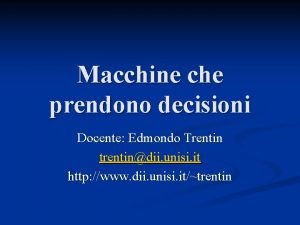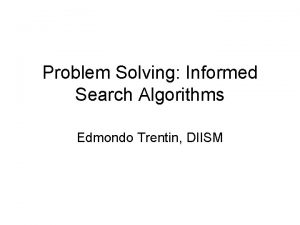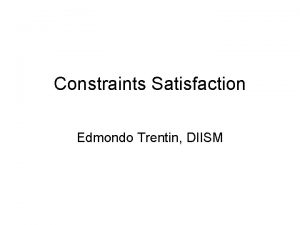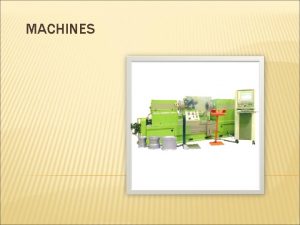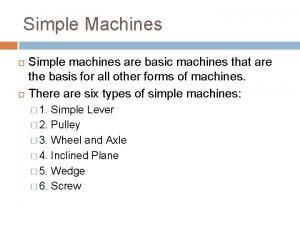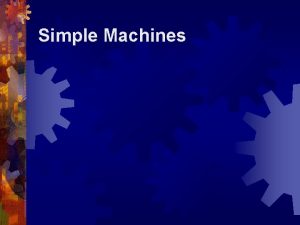Machines that Make Decisions Instructor Edmondo Trentin trentindii










- Slides: 10

Machines that Make Decisions Instructor: Edmondo Trentin trentin@dii. unisi. it http: //www. dii. unisi. it/~trentin

Decision (Classification) Problems The vending machine Speech recognition Lip reading Speaker recognition Identification for security issues (fingerprint recognition, other biometrics) Optical character recognition Image (e. g. , face) classification Classifiers for biomedical (e. g. , ECG) and bioinformatics (e. g. , functional and structural genomics) applications

General Diagram of the System Event Extract feature Classify Class 1. In the real world an EVENT takes place (eg. An instance of an object is detected) 2. PERCEPTION: a FEATURE EXTRACTION PROCESS gives a digitalized description of the event within a proper feature space 3. ACTION: a CLASSIFICATION PROCESS decides which CLASS the event belongs to (amongst c alternative classes)

Relevance of the Features The difficulty of a given classification problem depends on the specific features one is able/can afford to extract (eg. gender classifier) The features must be as compact (small dimensionality) and as informatively rich as possible

Types of Features Numeric (discrete or continuous): number of black pixels in a bitmap, frequency of a sound, angle of orientation of a line of handwritten text, weight and measures of an item, … Symbolic: symbols or strings of symbols over a given finite and discrete alphabet (eg. text on a web-page, sequence of amino-acids, . . . ) Qualitative: tall, short, big, small, red, blue, good, bad, normal, strange, … We will mostly use numeric features. Qualitative ones may be encoded with numerical values.

Feature extraction: example 1

Feature extraction: example 2 Waveform “Spectral” parameters

Discriminant Function Let us consider a c-classification task The patterns x are d-dimensional vectors For each class i, i=1, …, c, a discriminant function g(i, x) is sought such that: g(i, x)>g(j, x) iff x belongs to i-th class For each new event, the classifier decides on the class the event belongs to by picking that particular class whose discriminant function has the maximum value

Intuitive Approach 1: Probability Distributions of the Classes

Intuitive Approach 2: Separation Surfaces

